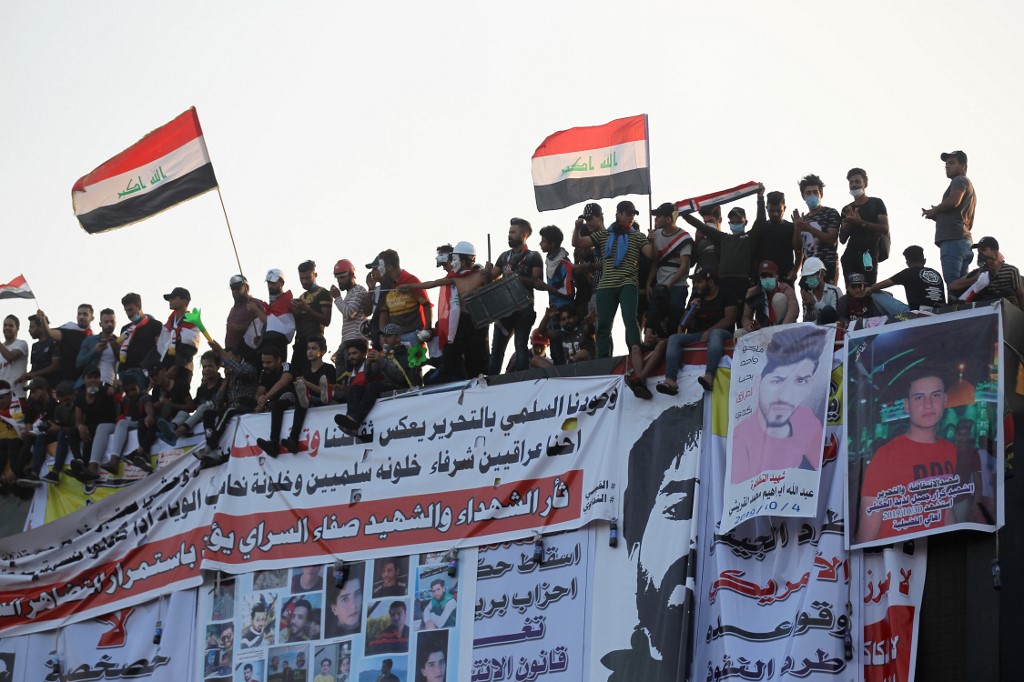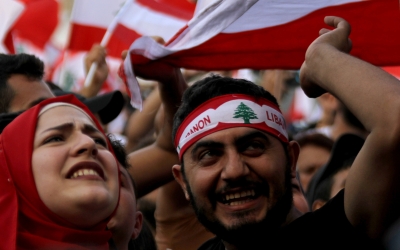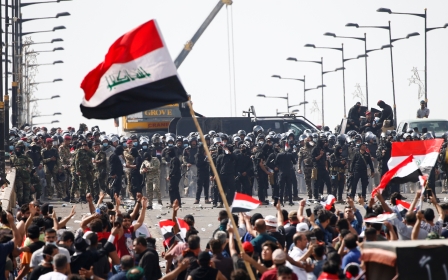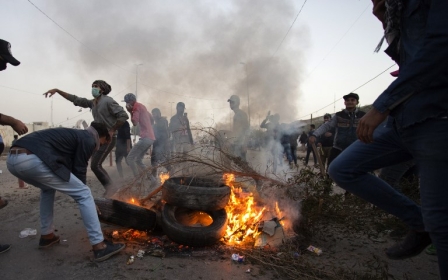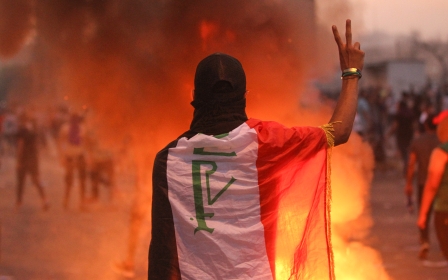Iraq protests: A new social movement is challenging sectarian power

The recent wave of protests in Iraq has been geographically concentrated in Shia regions, not yet spreading in any substantial way to Sunni or Kurdish provinces.
But this is not a Shia revolt, and any attempt to impose a sectarian framing on it fails to understand the underlying drivers. Shia symbols have not occupied a central place in the demonstrators’ slogans, and Shia clerical figures have been either absent or marginal in shaping the protests’ trajectory.
If anything, these protests have challenged the sectarian formula of governance, which has reduced Iraqis to their ethnic and religious identities and empowered factions that embedded these identities in their politics.
Socioeconomic demands
In Baghdad, the mobilisation was initially prompted by socioeconomic demands. The early demonstrations were crowded with unemployed and underemployed youth from the city’s eastern side, which has a dense Shia population.
New MEE newsletter: Jerusalem Dispatch
Sign up to get the latest insights and analysis on Israel-Palestine, alongside Turkey Unpacked and other MEE newsletters
The resilience of the movement and the disproportional violence it has faced attracted other social sectors, including students and civil society groups, who joined the second wave that started late last month. The movement grew as more people, including many from middle-class backgrounds, joined to create what resembles a social consensus on opposing the political elite and demanding a radical systemic change.
It has become the largest grassroots movement in Iraq’s modern history, producing new non-sectarian symbols, martyrs and a protest language.
This wave comes from the heart of the Shia community that these factions claim to represent
Dominant Shia factions have not faced such a challenge since they came to power after 2003. Unlike the Sunni protests of 2012-13, which were easy to portray as sectarian opposition, this wave comes from the heart of the Shia community that these factions claim to represent.
The crackdown against the protests in early October targeted the area bordering Sharq al-Qanat (a group of neighbourhoods located at the farthest east of Baghdad) and Sadr City, from where a large number of demonstrators hailed.
This is similar to where the security apparatus of the Saddam Hussein regime, which was dominated by Sunni Arabs, focused anti-riot activities in the capital in the 1980s and 1990s. For decades, Sadr City, which is inhabited by a large congregation of extremely poor and young people, has been a source of anti-regime mobilisation.
Challenging political Shiism
During this time, and especially after the waning of the Iraqi Communist Party, political Shiism became the main ideology through which this area protested its marginalisation, as was manifested in the movement of Mohammad Sadeq as-Sadr in the 1990s. Now, by once again making it a stronghold of anti-regime mobilisation, protesters are challenging the claim of the Shia Islamist factions to defend and represent Shia communities.
This mobilisation is indeed constructing a new boundary within the Shia community, defined by socioeconomic and class identities. It has the potential to transcend sectarian divisions and develop cross-sectarian solidarities, thus bringing into question the formula of sectarian quotas that has dominated the post-2003 political order. It has generated a new language of protest, directed against the dominant factions and their ideology: political Shiism.
The end of the threat posed by the Islamic State has accelerated the shift from sectarian politics into a pattern of politics shaped by socioeconomic inequalities and demands for better governance. It has been spurred on by declining oil prices, which diminished the resources needed to reduce unemployment.
Iraq’s population increases by about a million every year, and about half a million enter the job market annually. The rampant corruption of the government and the predatory behaviour of ruling factions, which have turned state institutions into fiefdoms for their patronage networks, have inhibited a more equitable distribution of oil rent, which - at about 93 percent of the governmental budget - is Iraq’s only source of income.
Systemic challenges
Corruption in Iraq is not simply a matter of personal greed and moral decay; it has become an integral part of the system. When people protest against corruption, poverty and inequality, they are opposing the very system that has deepened these problems.
Yet the current standoff suggests that meaningful change will be difficult to achieve. This is partly because the public has lost any faith in the government’s promises, and partly because power in Iraq is not concentrated in one place, but spread among multiple centres, making the “regime” incapable of acting cohesively.
This is the outcome both of the ethno-sectarian formula of governance, which has diffused power and resources among a variety of actors, and of the weakness of state institutions, which have allowed those actors, such as militias and paramilitary groups, to unaccountably contest the state’s authority on many levels, including challenging its monopoly on legitimate violence.
It will thus be difficult to initiate any serious reform that could threaten one of these centres of power - whether that centre is Tehran-controlled militias, the Kurdish government, or Muqtada al-Sadr’s group.
Given that the power of these groups is embedded in the system that the protesters oppose, they are only capable of agreeing on cosmetic changes, such as the economic reforms that Prime Minister Adel Abdul-Mahdi was mandated to undertake in the first place.
A new sense of belonging
Most protesters realise that the dominant, multi-sectarian oligarchy - which is dividing the spoils among its key patrons - is, in fact, the “Other” that resists their demands. This realisation has fostered the non-sectarian identity of the protest movement, and could develop cross-sectarian solidarities among society’s disaffected sectors.
The only way for the post-2003 system to survive in the long term is by drastically altering its nature
Even if the demonstrations lose momentum in the coming days, the structural problems that produced them will remain in place. The growing mass of discontented people, equipped with better awareness of their marginalisation and empowered by a new sense of belonging to a rightful collectivity, will continue to challenge the ruling oligarchy, perhaps in more radical ways.
The only way for the post-2003 system to survive in the long term is by drastically altering its nature, accepting the end of the ethno-sectarian formula and changing the rules of the game. This would be unlikely to happen without the growing protest movement; only a strong sense of imminent danger could lead the oligarchy to accept real concessions.
In a way, this is a confrontation and a negotiation between the old language of “sects” and a new language of citizenship and social justice.
The views expressed in this article belong to the author and do not necessarily reflect the editorial policy of Middle East Eye.
This article is available in French on Middle East Eye French edition.
Middle East Eye delivers independent and unrivalled coverage and analysis of the Middle East, North Africa and beyond. To learn more about republishing this content and the associated fees, please fill out this form. More about MEE can be found here.



